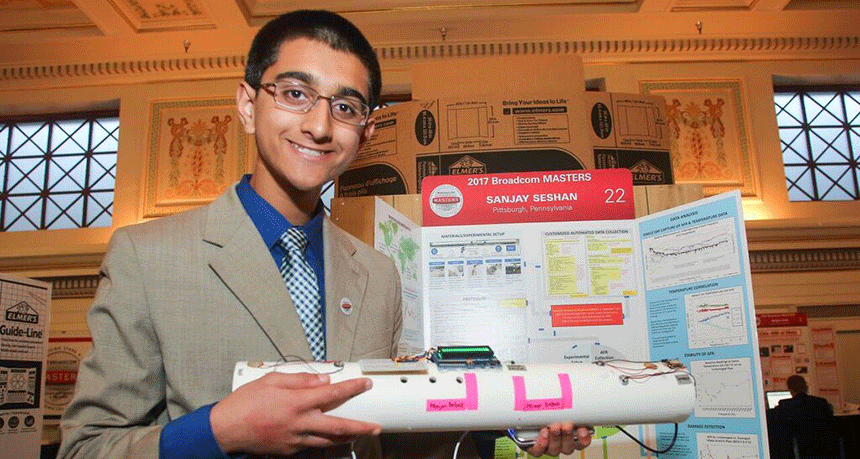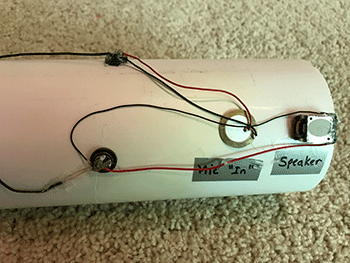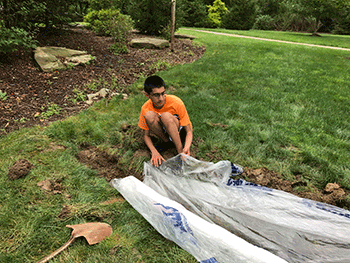Teen identifies way to detect failing underground pipes
A damaged pipe vibrates differently than one that’s intact, his data show

By rigging up a speaker and microphones to a water pipe, it might be possible to get early warning of damage that could lead to costly leaks.
Linda Doane/SSP
By Sid Perkins
WASHINGTON, D.C. — A leaky pipe can cause a lot of damage. In a home, it can ruin floors, walls and furniture. Outdoors, water leaking from a high-pressure water pipe can wash away soil and create sinkholes. And even before such leaks cause damage, they can rob communities of massive amounts of clean water needed for drinking and other uses. But a teen now reports a way to detect damage in a water pipe — even one buried in the ground. In some cases, his technique might find a failing pipe before it leaks a drop.
Sanjay Seshan, 15, attends Dorseyville Middle School in Pittsburgh, Pa. He presented his research here, October 21, at the finals of the Broadcom MASTERS science competition. (MASTERS stands for Math, Applied Science, Technology and Engineering for Rising Stars.) This event brings together 30 middle-school finalists each year for a special competition. Society for Science & the Public, which publishes Science News for Students, created the program in 2011. The Broadcom Foundation of Irvine, Calif., sponsors the event.

“Water leak” may bring to mind the slow drip, drip, drip of a bathroom faucet. Yet some leaks can be huge. And if there are enough of them, even small leaks can add up to massive losses, notes Sanjay. He first became aware of large-scale water leaks while traveling through a poor area in India. There, he recalls seeing just “one community pipe and leaking water everywhere.” When he returned home, Sanjay did some research. He learned that the U.S. water-delivery infrastructure is deteriorating, too. (Infrastructure is a term for the basic physical structures and facilities on which a society depends. These include roads, bridges, sewer systems, electrical power grids and phone systems.)
That deteriorating water infrastructure includes an estimated 240,000 breaks each year in water mains. These are the pipes that run water from treatment plants to neighborhoods. Overall, he learned, U.S. water-delivery systems lose some 7.6 trillion liters (2 trillion gallons) of water annually. That’s equal to the water needed to fill some 25 billion bathtubs. It’s also enough to provide every person on Earth about 1,000 liters (270 gallons) of water each year. Across North America today, Sanjay reports, about one liter (or quart) out of every 6.5 liters fed into water-distribution pipes simply disappears due to leaks. That a huge waste of money and clean water.
In poorer nations, the problem can be much worse. A 2004 report by the Asian Development Bank reports that the pipes in Delhi, India, lose a little more than half of all clean drinking water to leaks. In Dar es Salaam, a major city in the East African nation of Tanzania, about 60 percent of the city’s water disappears through broken pipes. That’s according to a 2003 report by the United Kingdom’s Department for International Development. In the many parts of the world where clean water is scarce, any loss is a big deal. But losses this high can sometimes prove tragic.
Detecting leaks
Such data motivated Sanjay to explore how he might scout for damage in buried water pipes. Finding a failing pipe before leaks become big and obvious would save a lot of water, he notes. An out-of-tune clarinet provided his inspiration.
A clarinet is essentially a long tube with holes that a player opens and closes to change the sounds coming out of the instrument. If a clarinet becomes damaged, those sounds will be slightly off. Sanjay figured that the way sound travels through a water pipe, another long tube, should change if the pipe becomes damaged. The teen then designed a way to test that. (And his parents were good sports, because some of his experiments involved digging up large parts of their backyard.)

Sanjay used lengths of pipe made from a type of plastic known as polyvinyl chloride, or PVC. He attached a tiny but powerful speaker to the outside of a pipe. He also attached two small microphones to the pipe. He put one near the speaker and another much farther away. Then, he used a computer program to send electrical signals to the speaker.
Those signals caused the speaker to vibrate at particular frequencies. A sound’s pitch is due to the frequency at which its sound waves vibrate. The lowest pitch he tested was 1000 hertz (cycles per second). He also tried six other frequencies, ranging from 2,000 to 20,000 hertz. In each case, he compared the size of the vibrations picked up by each of the two tiny microphones. He showed that the pipe transmitted some frequencies better than others. (This science of sound falls into a field known as acoustics.)
After measuring how well a healthy pipe transmitted each sound pitch, Sanjay damaged the pipe. In some cases, he drilled small holes. For other tests, he used a tool to scratch the pipe. (Those scratches were sometimes so shallow that they never would have caused the pipe to leak.) Then, Sanjay ran his tests again. The pipe’s sound transmission changed. This was true even for pipes 3 meters (about 10 feet) long that he’d buried in his backyard. So, he concludes, the technique offers hope that pipes could be rigged with sensors and then monitored over long periods.
There is one small issue, though. Sanjay notes that the technique only works when there are original measurements of sound transmission available from before a pipe is damaged. They will provide a value against which future measurements can be compared. While it would be possible to make measurements on pipes that have been in use a long time, engineers could only confidently measure damage that occurs in the future. The technique could not gauge how much had taken place in the past.
Still, says Sanjay, the technique might work on more than just buried pipes. Studies have suggested that bridges might vibrate differently if some of their parts have cracked.







